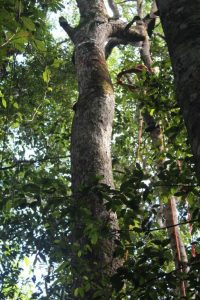16 December 2016
How do you track the mass of a tree over time? Watch it move.
Posted by dgaristo
By Sarah McQuate

Researchers have to climb about 20 meters high to hook an accelerometer around a tree’s trunk (the gray box toward the top of the tree).
Credit: Tim van Emmerik.
Dancing trees may be able to teach scientists about tree health during a drought, according to a new study.
New research shows accelerometers used to monitor tree movements could provide information about tree mass. Tracking swaying trees over time could help researchers detect changes in tree mass and better understand how trees are affected by drought.
“Every tree moves when it’s a little bit windy,” said Tim van Emmerik, a graduate student in civil engineering at Delft University of Technology in the Netherlands, who presented the new research Wednesday at the 2016 American Geophysical Union Fall Meeting in San Francisco. “You can also imagine if you have a very big, solid tree, it moves completely different than a very small tree.”
Van Emmerik and his team attached accelerometers to 20 different trees from seven different species in a forest near Manaus, Brazil, and left them there for one year. In the past, scientists have used accelerometers to determine how trees bend and break during storms. But these studies only monitored tree movement for short time periods from 30 minutes to an hour, according to Van Emmerik.
In the new study, the team found big, heavy trees move less in the wind compared to smaller trees, as one might expect. This leads the group to believe they can use their method to monitor smaller changes in tree movement that could inform them about tree health over time.
Trees take up water from the ground and combine it with carbon dioxide to make up their food. During a drought, trees can’t suck up as much water from the soil, meaning they will have less food and they will lose mass. When they lose mass, the trees will likely become smaller and lighter, and move differently — changes that can be tracked by the accelerometers.
By watching these fluctuations over time, researchers may be able to determine how trees respond to drought, Van Emmerik said.
Scientists are particularly interested in monitoring tree health in the Amazon, the largest rainforest on Earth. Trees in the Amazon remove a lot of carbon dioxide from the air, reducing the amount of this greenhouse gas in the atmosphere.
But the Amazon also has dry periods of the year, according to Van Emmerik. Understanding how trees in the Amazon cope with drought could help researchers better predict how well these trees will offset the effects of climate change, he said.
Although Van Emmerik’s data is preliminary, he hopes his team will be able to learn how different tree species are affected by drought. “Are some trees happier during the drought?” he wondered. “After a dry period, how fast are they able to suck up the water again and become healthy again?”
Van Emmerik also hopes to follow changes in mass in the same tree during the daytime and the nighttime, so researchers can have a detailed picture of how drought affects each tree during its day-to-day life in the forest.
“That’s the most interesting part,” he said. “That’s the golden egg.”
—Sarah McQuate is a science communication graduate student at UC Santa Cruz.










 GeoSpace is a blog on Earth and space science, managed by AGU’s Public Information staff. The blog features posts by AGU writers and guest contributors on all sorts of relevant science topics, but with a focus on new research and geo and space sciences-related stories that are currently in the news.
GeoSpace is a blog on Earth and space science, managed by AGU’s Public Information staff. The blog features posts by AGU writers and guest contributors on all sorts of relevant science topics, but with a focus on new research and geo and space sciences-related stories that are currently in the news.